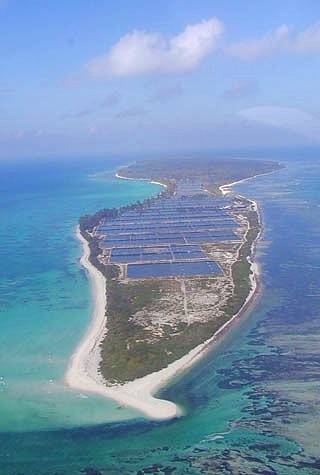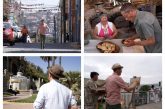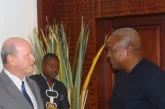
By Alain St.Ange of SAINT ANGE CONSULTANCY
Welcome to Edition #12 of 2017.
http://mailchi.mp/977e3c93025 c/saint-ange-tourism-report- 12th-edition
Our famous quote for today is one by Martin Luther King (Jr.) –
“Darkness cannot drive out darkness, only light can do that.
Hate cannot drive out hate, only love can do that.”
Hate has no home in the lives of those who value inclusion, tolerance and random acts of kindness. Many may be familiar with the song lyrics, “Let there be peace on Earth, and let it begin with me.” Many of you share this sentiment. Hate disrupts lives and in turn hurts businesses.
In Seychelles, we know that the economy is facing real challenges which will impact on the lives of the average citizen. As an island Nation, we remain dependent on tourism. A recent survey in Australia recently concluded that Travel Agents remain more relevant than ever for tourism. Travel Agents use Tour Operators’ published programs and their tourists are generally met and handled by a Destination Management Company (DMC).
Extracts from the edited notes by Peter Needham on the recent survey reveals:- Three quarters of Australian travelers view travel agents as a “trusted source of travel and safety advice” – a major increase over the 57% figure recorded in 2012. The findings, which derive from a survey conducted by travel insurer SureSave, also show that in 2017, “40% of Australians booked their last overseas leisure trip with a travel agent (either in-store, over the phone or via email)”.
“Travelers are still turning to agents for their travel booking and insurance needs, but not because they view agents as the default booking option,” Ross McDonald, SureSave’s general manager distribution commented, “They’re coming back to agents time and time again as they genuinely seek and value the level of knowledge and expertise that agents offer.”
Travelers are also becoming increasingly savvy about the intricacies of travel insurance, and in particular the “window of risk”, which identifies the earliest point at which a traveler is at risk of being out of pocket. In 2017, 53% of respondents purchased travel insurance “at the same time as booking their holiday”, in comparison to only 37% in 2012.
“We can attribute this marked improvement in part to the efforts of agents to educate their customers,” McDonald said.
“Of the respondents who booked travel plans through an agent, 86% revealed that their agent had explained the benefits of purchasing travel insurance at the same time as booking their travel plans. In terms of ensuring that travelers are informed and well-prepared in advance of their holiday, the role of the agent is crucial and is becoming more important each year. We’re passionate about ensuring that agents are well-equipped with the right information and tools so their customers are able to choose the travel insurance policy that’s right for them.”
For Seychelles, it should never be forgotten that Tour Operators have been the faithful partners of the island’s tourism industry for decades, their printed programs proudly occupying many a shop window in key tourism source markets. This has helped to keep Seychelles visible and relevant as a tourism destination. The local agents of these Tour Operators, the DMCs on their part, continue to work with the Tourism Board to promote Seychelles products, making it a win-win for the country and local businesses.
Seychelles today needs to refocus on all of its tourism niche markets. The traditional niche markets of diving, sailing, fishing and bird watching must continue to be promoted. However, the time has come to boost and nurture the cruise tourism market in Seychelles. The port where tourists will disembark is the first experience the visitors will have of a given island; they will step onto the concrete slab, amid industrial containers, armed with their professional cameras, with nothing to take photographs of. Therefore, we must ensure our port is worthy of their scrutiny and attention. Moreover, with the town of Victoria abandoned by shopkeepers and businessmen after midday on Saturdays, and becoming a barren wasteland on Sundays, there is not much for tourists to see and do in the country’s capital on weekends. Local eateries are few and far between, and in terms of entertainment, the average tourist would have to travel to the other side of the island to engage in some water activities.
An example of a market which is yet to be tapped into is that of Casino Junkets. Casino operators would hire junketeers to fill a plane with qualified gamblers. These players would get free airfares, free hotel accommodations, free meals and free shows in exchange for their commitment to gamble a specific number of hours per day at an explicit average bet size. Casinos, of course, are operating on the assumption that the players would lose more than their out of pocket expenses for bringing, accommodating and feeding them.
With that said, it is important to again acknowledge all who are diligently re-posting the Saint Ange Tourism Report weekly. Our Report ranges far and wide, from Australia to the Americas, Africa to Asian and Greater Europe, with your continued support, which is greatly appreciated. You are helping us to go from strength to strength with each new Edition.
Enjoy the read,
Alain St.Ange
Saint Ange Consultancy
Aquaculture in Seychelles?
As Seychelles looks for ways to grow its economy further, officials have steered towards the idea of Marine aquaculture (Mariculture). Mariculture refers to the culturing of marine species in sea pens, on the seafloor, or suspended in the water column or in on-land, man made systems such as ponds or tanks.
The concept is not new to Seychelles. In 1989, the Island Development Company (IDC) and the Seychelles Marketing Board (SMB) established a prawn farm on the largest coralline island of Seychelles, Coetivy. The farm specifically cultured the Black Tiger Prawn, which is renowned globally for its exquisite taste. The operation was later abandoned in 2009 due to financial constraints, leaving the once beautiful island covered in concrete scars that are still apparent today.
There is also a currently operational black pearl oyster farm situated on Praslin, the second-most populated island of Seychelles. The farm was established in 1995, and produces the black lipped oyster and winged oyster specifically for the retailed jewelers market.
The newly emerging mariculture endeavor has identified four finned-fish species for the pilot project. They include the brown-marbled grouper, the iconic red emperor snapper, the mangrove snapper and the snub-nosed pompano. The fish produced will be almost exclusively for export and it is hoped that the industry will boast between 20,000 and 50,000 tonnes per annum.
Aquaculture brings with it several benefits (if it is done right). Mainly, it can reduce fishing pressure from wild stock. With the increasing demand for seafood globally, aquaculture produces a continuous food supply. This would be especially useful during the South-East Monsoon in Seychelles where fish stocks are limited due to rough seas. The industry can also create new job sectors, offering skilled opportunities in science and technology, thus expanding the local workforce.
Unfortunately, aquaculture also has significant environmental disadvantages. escapees may pose a threat to wild species. Cultured fish will most likely be reared from hatchlings and throughout time cause genetic dilution. If one of these fish escape into the wild and manages to breed with a wild specimen, drastic genetic loss may take place causing a disastrous rippling effect in nature. Furthermore, the methods that will be incorporated in Seychelles include floating pens. These pens allow for waste materials such as fecal matter and uneaten food scraps to be deposited on the seafloor which can be carried by sea currents towards neighbouring coral reefs, seagrass habitats and mangrove forests causing possible detriment to these vital ecosystems.
In addition this waste material can be the source of an emerging artificial food chain. Uneaten food may attract fish from the wild towards the pen, with it brings larger predators, such as sharks which may add an increased risk to swimmers. Other major environmental concerns include the use of a variety of chemicals, including antifoulants, pesticides, and antibiotics, which can have negative effects on marine ecosystems or even human health.
The relevant authorities in Seychelles had hosted several public consultations with international consultants of the project present to address any questions. I personally attended several of the meetings to gain an insight into the views of the public. It was made clear that the majority of the citizens present at the meetings were against the project altogether. Several concerns were raised, such as why local scientific expertise was not consulted in the development phase instead of relying solely on foreign consultants to decide the fate of the project? Another interesting point that was raised was why were more sustainable species, such as shellfish, not considered?
The major issue raised, however, was the fear of possible increase in shark activity. The consultants were quick to state that there is no scientific proof that shark frequency is increased with aquaculture pens. However, several scientific studies done around the world have demonstrated that sharks do in fact show increased activity in areas containing aquaculture pens, thus increasing risks to human attacks (e.g.,Galaz & de Maddalena 2004, NOAA 2005). Looking closer to Seychelles, a recent publication in the African Journal of Marine Science demonstrated the large bull sharks are showing high site fidelity to aquaculture pens around Reunion Island (Loiseau et al. 2016). Although shark attacks on humans are a rare occurrence, the fact remains that increased shark activity in coastal areas that are prominent swimming spots by tourists and locals are going to be put under greater risk.
Back in 2012, Seychelles was smeared over international media after there were two fatal shark attacks that occurred within weeks from each other, and in the same bay on Praslin Island. The cause of the attacks where most likely due to constant food disposal from yachts and other pleasure boats that frequently docked in the area. This theory was considered most likely by shark experts that were leading the investigation. These chumming activities may have altered large shark feeding behaviour, thus attracting them to the bay where the attacks happened. Could the aquaculture pens in Seychelles cause the same effect?
Although there is a great downside to aquaculture, all of these risks can be managed to a bare minimum if strict protocols are followed. Let us not forget that tourism remains the main pillar of the Seychelles Economy. Venturing into other avenues of economic growth may prove to be an even greater asset to Seychelles. However, one needs to question whether it is worth the risk.
Article by Ameer Ebrahim, Environmental Consultant
References
Galaz T, de Maddalena A (2004) On a great white shark trapped in a tuna cage off Libya, Mediterranean Sea. Annales Series Historia Naturalis 14:159-163.
Loiseau N, Kiszka JJ, Bouveroux T, Heithaus MR, Soria M, Chabanet P (2016) Using an unbaited stationary video system to investigate the behaviour and interactions of bull sharks Carcharhinus leucas under an aquaculture farm. African Journal of Marine Science 38:73-79.
NOAA Small Business Innovation Research Program (2005) Development of effective and low cost predator exclusion devices for offshore aquaculture facilities in the United States EEZ. Contract No. DG133R05-CN-1200: Snapperfarm, Inc.









